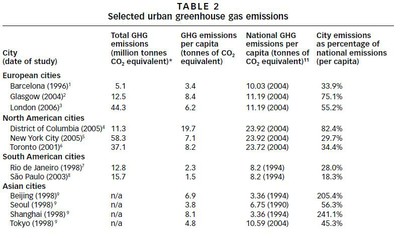Who’s to blame for climate change? The author of a study published in Environment and Urbanization take on the role of detective trying to find who is releasing the emissions creating climate change. Their hope is to clear cities as the prime suspect.
After comparing existing inventories of emissions at the national and city level the author concludes that cities aren’t to blame. The study compares findings from 11 different city-level inventories with separate nation-level inventories. When placed side by side these inventories show that cities emit less, per capita, than the country they are in.
In almost every case—except the cities in China—the per capita emissions of the cities are lower than the per capita emissions of the country. For example, Washington DC emits 19.7 metric tons of CO2 annually per capita while the United States emits 23.92 metric tons per capita.

[See bigger and clearer table here.]
It’s more evidence that cities can be climate solutions, but it is worth noting that, the study’s approach is methodologically hazardous, since the studies of city emissions and country emissions were done by different groups at different times. There are few uniform standards for emissions inventories and there are almost certainly important methodological differences the accounts. Still, given the available data, the analysis is a helpful starting point.
Even though cities aren’t the prime culprit, they can still help solve climate change. They are well-situated to use zoning and technological innovation; and with high concentrations of people it may be easier to encourage large-scale behavior change to reduce green house gas emissions.








mynalee johnstone
The problem with cities is the automobile. Its not just the Emissions. Its the NOISE, the stress, the craziness and busyness and chaos created by overuse of the automobile. If there was a carfree city I would move there right now!
Don W.
The reason for the disparity is that most industrial plants are located outside the city limits, in the county, not in the city. That is in large part due to differences in zoning and planning, as well as tax issues. Cities due contribute to the problem by adding zoning rules and regulations requiring extensive landscaping and other amenities that use and absorb great deals of energy and resources to install and maintain, including water and landfill waste from mowing the grass and pruning-maintaining shrubbery and trees. They also use fossil fuels to run trucks and equipment to clean and maintain the large commercial properties that can have substantial landscaping requirements imposed on them by cities!! Cities also require that numerous parks and recreational areas are part of subdivisions-most of those areas never get used by the residents.GHG are not the only problems we are dealing with-please don’t let the cities off the hook yet-they do contribute to the problem.